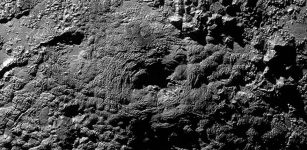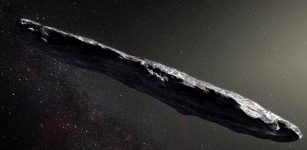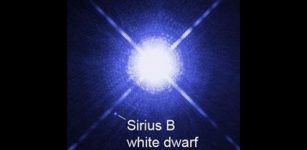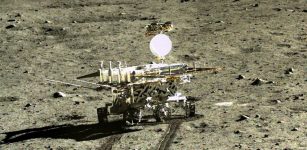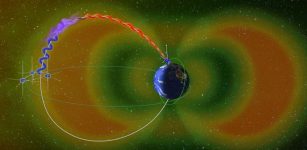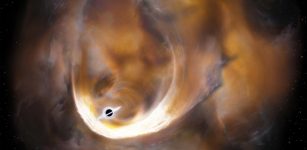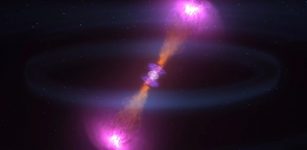Metal-Rich Galaxy In Early Universe – Discovered
Eddie Gonzales Jr. – MessageToEagle.com – Scanning the first images of a well-known early galaxy taken by NASA’s James Webb Space Telescope (JWST), Cornell astronomers were intrigued to see a blob of light near its outer edge.
Their initial focus, and the infrared observatory’s target, was SPT0418-47, one of the brightest dusty, star-forming galaxies in the early universe, its distant light bent and magnified by a foreground galaxy’s gravity into a circle, called an Einstein ring.
The moment 0 map and spectrum snippets of the strong emission lines. For each strong line(s), the lens-subtracted, continuum-subtracted moment 0 map is displayed in the first row, with the same marked regions as in Figure 1. The spectrum snippets are shown in the second row, integrated over the three regions. The spectra are offset vertically to aid vision, with the zero baseline indicated by a thin black line. The green dashed line indicates the Gaussian fit to the line or line associations plus the linear fit to the local continuum. The labeling style and color of the spectrum are the same as Figure 1. Credit: The Astrophysical Journal Letters (2023). DOI: 10.3847/2041-8213/acb59c
But a deeper dive into the early JWST data released last fall produced a serendipitous discovery: a companion galaxy previously hidden behind the light of the foreground galaxy, one that surprisingly seems to have already hosted multiple generations of stars despite its young age, estimated at 1.4 billion years old.
“We found this galaxy to be super-chemically abundant, something none of us expected,” said Bo Peng, a doctoral student in astronomy, who led the data analysis. “JWST changes the way we view this system and opens up new venues to study how stars and galaxies formed in the early universe.”
Peng is the lead author of “Discovery of a Dusty, Chemically Mature Companion to z~4 Starburst Galaxy in JWST Early Release Science Data,” published Feb. 17 in the Astrophysical Journal Letters, with eight co-authors who are current or former members of the Department of Astronomy in the College of Arts and Sciences.
Earlier images of the same Einstein ring captured by the Atacama Large Millimeter/submillimeter Array (ALMA) in Chile contained hints of the companion resolved clearly by JSWT, but they couldn’t be interpreted as anything more than random noise, said Amit Vishwas, a research associate at the Cornell Center for Astrophysics and Planetary Sciences (CCAPS) and the paper’s second author.
Investigating spectral data embedded in each pixel of images from JWST’s NIRSpec instrument, Peng identified a second new light source inside the ring. He determined that the two new sources were the images of a new galaxy being gravitationally lensed by the same foreground galaxy responsible for creating the ring, although they were eight to 16 times fainter—a testament to the power of JWST’s infrared vision.
Further analysis of the light’s chemical composition confirmed that strong emission lines from hydrogen, nitrogen and sulfur atoms displayed similar redshifts—a measure of how much light from a galaxy stretches into longer, redder wavelengths as it grows more distant. That placed the two galaxies roughly the same distance from Earth—calculated as a redshift of about 4.2, or about 10% of the universe’s age—and in the same neighborhood.
To verify their discovery, the researchers returned to earlier ALMA observations. They found an emission line of ionized carbon closely matched the redshifts observed by JWST.
“That really nailed it down,” Vishwas said. “Because we have several emission lines shifted by exactly the same amount, there’s no doubt that this new galaxy is where we think it is.”
The team estimated the companion galaxy, which they labeled SPT0418-SE, was within 5 kiloparsecs of the ring. (The Magellanic Clouds, satellites of the Milky Way, are about 50 kiloparsecs away.) That proximity suggests the galaxies are bound to interact with each other and potentially even merge, an observation that adds to the understanding of how early galaxies may have evolved into larger ones.
The two galaxies are modest in mass as galaxies in the early universe go, with “SE” relatively smaller and less dusty, making it appear bluer than the extremely dust-obscured ring. Based on images of nearby galaxies with similar colors, the researchers suggest that they may reside “in a massive dark-matter halo with yet-to-be-discovered neighbors.”
Most surprising about the companion galaxy, considering its age and mass, was its mature metallicity—amounts of elements heavier than helium and hydrogen, such as carbon, oxygen and nitrogen. The team estimated that as comparable to our sun, which is more than 4 billion years old and inherited most of its metals from previous generations of stars that had 8 billion years to build them up.
“We are seeing the leftovers of at least a couple of generations of stars having lived and died within the first billion years of the universe’s existence, which is not what we typically see,” Vishwas said. “We speculate that the process of forming stars in these galaxies must have been very efficient and started very early in the universe, particularly to explain the measured abundance of nitrogen relative to oxygen, as this ratio is a reliable measure of how many generations of stars have lived and died.”
The researchers have submitted a proposal for JWST observing time to continue study of the ring and its companions and reconcile potential differences observed between the optical and far-infrared spectrum.
“We’re still working on this galaxy,” Peng said. “There’s more to explore in this data.”
Written by Eddie Gonzales Jr. – MessageToEagle.com Staff


